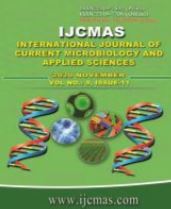


 National Academy of Agricultural Sciences (NAAS)
National Academy of Agricultural Sciences (NAAS)

|
PRINT ISSN : 2319-7692
Online ISSN : 2319-7706 Issues : 12 per year Publisher : Excellent Publishers Email : editorijcmas@gmail.com / submit@ijcmas.com Editor-in-chief: Dr.M.Prakash Index Copernicus ICV 2018: 95.39 NAAS RATING 2020: 5.38 |
A study was carried out to customize enzymes specific to tapioca flour to improve its nutritive quality. Tapioca flour was rich in crude fibre (15.45±7.22%) and soluble carbohydrate (78.27±7.01%) content. Hemicellulose was higher in tapioca flour. The per cent glucan, xylan and arabinan in tapioca flour were 27.67±1.62, 29.40±0.45 and 24.19±1.78%, respectively. An experiment was done to fix the required level of enzymes for tapioca flour (first experiment) with six replicates in each stage of experiment. The respective levels of cellulase, xylanase, glucanase, pectinase and amylase identified for tapioca flour were 21.0, 18.0, 0.6, 16.0 (U/g) and 12000 (IU/g). As the enzymes used are found to have associated enzyme activities and in particular the xylanase enzyme was found to be effective in the release of monomer, only xylanase enzyme at the concentration of 0.016 g/g of tapioca flour as selected level of enzyme was used in further experiments. In the second experiment, five treatments viz., selected level, two levels lower (5% and 10%) and two levels higher (5% and 10%) than the selected level, each with six replicates in completely randomised design were tested to arrive at the “customized enzyme mixture” for tapioca flour. Significantly (p<0.05) highest release of monomers per g of tapioca flour were noticed in 5% and 10% lower than the selected level, therefore 10% lower level may be used to evolve “Customized enzyme mixture for tapioca flour”.
 |
 |
 |
 |
 |